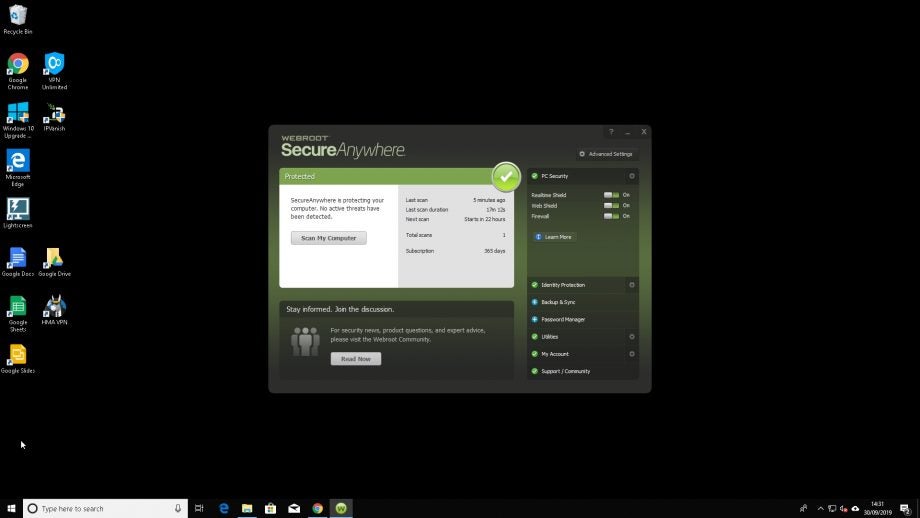Webroot SecureAnywhere AntiVirus Review
Webroot SecureAnywhere AntiVirus Review
Webroot's SecureAnywhere security package comes with an optional password manager and cloud backup, but how does it fare at virus detection?

Verdict
Webroot’s anti-malware suites have an excellent range of features for their price, but the malware detection engine has fared very poorly in recent tests, making the software impossible to recommend.
Pros
- Good range of features
Cons
- Poor antivirus performance
Key Specifications
- Review Price: £22.49
- Clients for Windows, macOS, Android, iOS
- 1 device
- Firewall enhancement
- Browser link checking
- Webcam protection
- Silent detection mode
What is Webroot SecureAnywhere AntiVirus?
Bought by cloud storage giant Carbonite in March 2019, Webroot has been in the antispyware and antivirus businesses since the early 21st century.
Webroot’s software sadly isn’t as widespread as that of many rival anti-malware suites, which not only limits the number of test results we have available to inform our verdict, but also means that you’re not as likely to find cheap retail editions, although there are a few knocking around eBay.
This means the most reliable pricing for Webroot SecureAnywhere AntiVirus is currently £22.49 for a year’s single-computer subscription at Webroot’s own UK website. That’s a 25% discount on the RRP, and it’s available to existing subscribers, although the price can change and the full renewal cost is £29.99.
If you want extra features, SecureAnywhere Internet Security Plus adds a password manager – actually a LastPass subscription – and covers three devices for £37.49, while Internet Security Complete provides 25GB of online backup storage for a current price of £48.79. You can also integrate their VPN Webroot Wifi Security.
Features, set-up and usability
Webroot makes it clear at install time that its online SecureAnywhere account is strictly optional, but even for the basic SecureAnywhere AntiVirus suite it provides helpful remote status information on your protected systems. At more expensive tiers, it provides access to your online storage, mobile antivirus and LastPass subscription, which can also be used to extend and existing LastPass subscriptions.
The SecureAnywhere desktop interface is attractive, clear and easy to use, although some font choices are a little on the small side. Buttons allow you to optionally disable core features such real-time protection and firewall, and there’s a web shield for all the usual browsers that alerts you to potentially malicious websites and search result links.
Webroot’s firewall enhances the Windows firewall with extra monitoring capabilities, using the company’s own contextual threat intelligence to alert users to online activity by unknown and potentially suspicious apps.
Also enabled by default are anti-phishing and tools that activate when you access a potentially sensitive website such as your online banking portal – these are all components that you should leave enabled.
All versions of SecureAnywhere come with a process manager with per-process blocking capabilities and a sandbox to run suspicious programs in, as well as the usual logs, quarantine management and statistics you’d expect from a decent antivirus suite.
Advanced settings allow you schedule scans, restrict access to SecureAnywhere’s settings and configure it to show more alerts – by default, it acts silently in the background.
Related: Best Antivirus 2019
Webroot – Performance
| Testing facility | AV-TEST | AV Comparatives | SE Labs |
| Real-World Threat Protection | 73.8% | N/A | N/A |
Webroot’s an established player in the anti-malware world, but its SecureAnywhere range of antivirus products don’t get tested very often. Fortunately, real-world live exposure and reference malware detection tests were carried out by AV-TEST in May and June 2019, allowing us to assess the software’s performance against a recent set of viruses.
Unfortunately, that performance was not very impressive. Both May and June results were little short of catastrophic in the vital real-world exposure tests: a test scenario in which the system is exposed to attacks of the kind you’d encounter in the wild, such as drive-by downloads of fresh malware via the web.
In the May tests, SecureAnywhere protected against 81.1% of malware attacks, but this percentage dropped to just 66.5% in June. By comparison, Microsoft Windows Defender – the antivirus solution that comes free with Windows 10 – protected against 100% of malware samples in the same test and again in AV-TEST’s latest follow-up.
It’s SecureAnywhere’s real-world test performance that most emphatically brings the software’s overall review score down. Its ability to recognise recent widely available malware samples from a reference was only a little worse than some of its rivals, at 99.3% in May and 98.9% in June.
It did relatively badly in AV-TEST’s usability ratings, falsely detecting 33 legitimate programs as malware, while most rivals’ false positive rates were in single digits and Windows Defender misidentified none at all. To its credit, SecureAnyway isn’t too much of a system hog, although it can slow down software installation and network file transfers more than most rivals.
Buy Webroot SecureAnywhere here
Should I buy Webroot SecureAnywhere AntiVirus?
Until Webroot works on getting both false positive detection rates down and malware protection levels up, it’s going to be very hard to recommend SecureAnywhere as a credible antivirus option. That’s a shame, because the interface is approachable and easy to get familiar with, and the ability to add extra features like cloud backup storage and a password manager is always welcome.
Verdict
Good prices and features can’t make up for the fact that recent performance has been seriously underwhelming.


